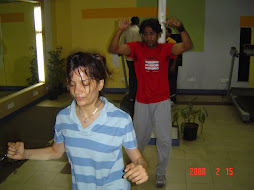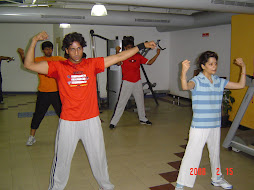What kind of exercise -- and how much -- is best when you're
trying to lose weight?
The two things that stop people
from losing weight with exercise are either boredom or injury!
The truth is that weight loss is
about creating a calorie deficit, that is, burning more calories than you take
in. So, always start with something you can do, like walking or working out on
an elliptical machine or exercise bike.
Swimming is a great weight loss activity.
While swimming is great for increasing
lung capacity, toning muscles, and even helping to burn off excess tension, the
surprising truth is that unless you are swimming for hours a day, it may not
help you lose much weight.
The buoyancy of the water is
supporting your body, so you do not end up working as hard as it would if, say,
you were moving on the ground, for e.g. like ‘running’!.
Also, it is not uncommon to feel
ravenous when you come out of the water. So, it may actually cause you to eat
more than you normally would, making it harder to follow your diet!
If you are not Sweat alot,
you're not working hard enough!
Sweating is not necessarily an
indicator of exertion. Infact, Sweating is your body’s way of cooling itself.
It's possible to burn a
significant number of calories without breaking a sweat: Try taking a walk or
doing some light weight training.
Yoga can help with all sorts of back pain.
The truth is that yoga can help
with back pain, but it's not equally good for all types.
If your
back pain is muscle-related, then yes, the yoga stretches and some of the
positions can definitely help. It can also help build a stronger core, which
for many people is the answer to lower back pain.
But if your back problems are
related other problems (such as a ruptured disc) yoga is not likely to help.
What's more, it could actually irritate the injury and cause you more pain.
If you do
have back pain, get your doctor's OK before starting any type of exercise
program.
Our ‘Take’ on Strength Training
You will always burn more
calories with cardio (aerobic) exercise than with strength or resistance
training.
Strength training
itself will not lead to an appreciable amount of weight loss because it just
doesn't burn enough calories. And the theory, that more muscle mass equates to
more calories burned, even when you're at rest? It's a myth!
That's not to say that strength
training isn't important for the overall health of the body. But when it comes
to burning the most calories, go for cardiovascular exercise. Aerobic
base-building workouts are the best, where you alternate between moderate and
higher intensity, either within the same workout or on alternate days.
Cross-training is highly
recommended, that is, doing a range of different activities during your
workouts. Not only does this help you keep from getting bored, it's better for
your body. Doing different activities recruits different muscle groups. You're
also less likely to develop an injury, since doing the same thing day after day
creates wear patterns on your joints.
An Aerobic workout boosts your metabolism for hours after your
Workout!
This is true! But the calorie
burn is probably not nearly as much as you think!
While your metabolism will
continue to burn at a slightly higher rate after you finish an aerobic workout,
the amount is not significant. In fact, it allows you to burn only about 20
extra calories for the day, which is marginal and it doesn't really count towards
your overall caloric burn.
As long as you feel OK when you're working out, you're probably
not overdoing it.
One of the biggest mistakes
people tend to make when starting or returning to an exercise program is doing
too much too soon. Infact, in most cases, you don't really feel the strain until
a day or two later!
No matter how good you feel when
you return to an activity after an absence, you should never try to achieve how
much or how hard you worked in the past. Even if you don't feel it at the
moment, you'll feel it in time, and it could lead to some sort of muscle
injury!
Machines are a safer way to Exercise
Although it may seem as if an
exercise machine automatically puts your body in the right position and helps
you do all the movements correctly, that's only true if the machine is properly
adjusted for your weight and height.
However, you can make just as
many mistakes in form and function, and have just as high a risk of injury, on
a machine as if you work out with free weights or do any other type of non
machine workout.
If you are not feeling some pain if you're going to gain any
benefits
Of all the fitness rumors ever to
have surfaced, experts agree that the ‘no pain-no gain’ holds the most
potential for harm. While you should expect to have some degree of soreness a
day or two after working out that's
very different from feeling pain while
you are working out.
A fitness activity should definitely
not hurt while you are doing it, and if it does, then either you are doing it
wrong, or you already have an injury.
As for ‘working through the pain’
it is advisable that if it hurts, to stop, rest, and see if the pain goes away.
If it doesn't go away, or if it begins again or increases after you start to
work out, please definitely see a doctor!
Regards,
Reema Sarin
Founder
‘BOLLYFIT’
Actor, Model, Anchor, Bollywood
Dancer & Choreographer
Join on Facebook - Reema Sarin – The BOLLYFIT Girl!
www.reemafitness.com









1 comment:
Weight Loss Surgery
Post a Comment